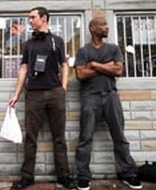There’s a strong impulse right now to organize stories by space, rather than time. Check out This American Life’s Story Globe, or the various wings of Localore. It seems a natural extension of our communication technologies to map our environments with stories, and (attempt) to chronicle the fantastic volume of human experience that takes place all around us, all the time.
I think this trend in storytelling is also part of a broader cultural move towards organizing our lives according to space (eating local foods, supporting local economies). But the impulse to put a story on a map can be taken one step further; it can be applied to the structure of a story itself. You can organize a story by the space in which it took place, rather than by the order in which it unfolded in time. Careful, though: when space becomes the supporting structure of your story, you’re unlikely to end up with a traditional narrative arc. And if you don’t have that, then you might have to find something else to keep your listeners in their seats.
Out of the Blocks does a great job finding that something else. As a tour of the 3300 Greenmount Avenue block in Baltimore, it’s an experiment in spatial story structure and employs some innovative modes of capturing listener interest. Host Aaron Henkin literally walks us down the block. We visit a hair salon, a restaurant, tattoo parlor, pawn shop, check cashing business, licensing office, and meet a passel of characters on the street. Through these interactions, we develop a regard for the diversity that’s present in this tiny plot of urban space. But there’s not a lot of action or suspense in this story, and it risks becoming a list-like parade of character portraits. A promise of another kind keeps our attention through the hour:
Wendell Patrick’s luxuriant use of sound.
This story holds our attention not by the usual hook of plot suspense, but by sonic variation. Sound, either through intensive editing, manipulation of voices, or wonderfully immersive music, places emphasis on certain passages, provides chapter markers, and cultivates the continual promise of surprise. Through this assemblage of sounds, we develop greater insight to and greater appreciation for each person we meet.
A shining example of this is a phone conversation starting at 14:35. A woman at the licensing office answers the phone and quickly tires of her customer’s questions. We hear her become frustrated as the conversation escalates, and she hangs up the phone. “Thirty-one minutes and thirty-seven seconds with this chick on the phone!” she says (at 15:35). This cues us into the kind of editing that Patrick put into this piece: that thirty-one minute conversation took only one minute for us to listen to. He literally cut 97% of the original tape, and yet through the snippets that remain, we get a great sense of this woman and her day-to-day frustrations at work. And portraits of such microcosms keep coming, and keep expanding, and always with as much of a sonic twist.
The expansive quality of each vignette keeps us curious, and we come out of the story with a real appreciation for this single Baltimore block. This is not to say that you can’t create a story that is organized by space rather than time, and have your traditional narrative arc too (I’d love to hear it!). But this is to say that if you want to investigate a particular space, and you find yourself creating a story without an arc, then there are other modes of generating promise.
Out of the Blocks
Aaron Henkin with music by Wendell Patrick
Hearing Voices, July 2012
52 min
{jcomments on}

